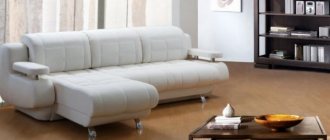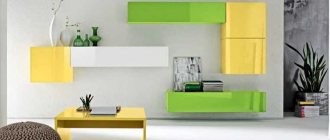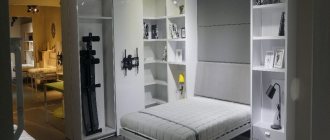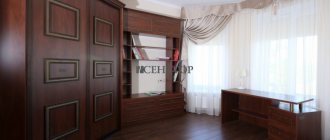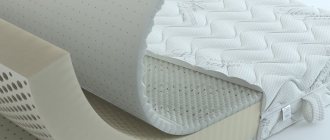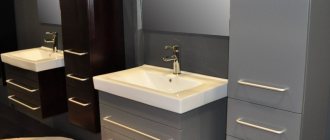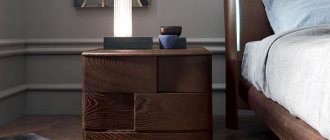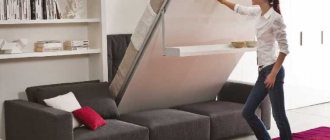Basic styles of furniture in the interior
Interior trends were formed in a certain era with the coming into fashion of certain things. In an effort to decorate their homes, people chose furniture of various geometric shapes and various shades, making the space cozy and functional. Subsequently, the selected details of the decor became real canons of art, turning into a single harmonious system.
Today there is a huge variety of furniture, stylized for different historical periods. Designers highlight two main directions:
- antique, or ancient styles, embodying the fashion of past centuries and decades;
- modern trends that have recently appeared simultaneously with the development of technology and mass industrialization of industry.
Let's take a closer look at each fashionable design direction and its unique features. Furniture styles with photos and descriptions are presented below. By reading the detailed specifications and looking at the photos, you can easily navigate all the style solutions for furniture, and decide for yourself which design direction matches your inner feeling at home.
[edit] Types of furniture by operational purpose
[edit] Household furniture
- for Bath
- for kitchen
- for cottages or gardens
- for the hallway
- for office
- for public spaces
- for the bedroom
- for a common room
- for the dining room
- for living room
[edit] Furniture for public spaces
- medical
- laboratory
- for preschool institutions
- educational institutions
- trade enterprises
- Catering
- consumer services
- hotels and sanatoriums
- theatrical and entertainment institutions
- libraries and reading rooms
- sports facilities
- administrative premises
- waiting rooms of transport institutions
- communications enterprises.
[edit] Furniture for transport
| This section of the article has not been written. According to the plan of one of the Cyclopedia participants, a special section should be located in this place. You can help by writing this section. |
[edit] Furniture for outdoor use
| This section of the article has not been written. According to the plan of one of the Cyclopedia participants, a special section should be located in this place. You can help by writing this section. |
Antique furniture and styling for it
Such products reproduce the atmosphere of a certain era: from ancient times to recent centuries. If we consider historical styles, they are always natural materials, regular geometric shapes and smooth soft tones of upholstery. The antique style in furniture is also called classic or historical. This furniture has elegant lines and timeless beauty. Tables, armchairs, sofas and chairs are respectable, comfortable and give a unique feeling of peace and comfort. What you should avoid when styling when choosing things is museum-likeness and stiffness. When choosing a sofa or bed, it is important to feel the desire to sit or lie down, and not to arrange objects and admire them, being afraid to approach.
Antique objects amaze with their variety of designs and speak of their owner’s love for beauty, emphasizing status and individuality. Furnished in antique style, the house is a sign of luxury and wealth.
The furniture of the past was richly decorated and made from expensive types of ebony and mahogany, usually by hand, using special technologies passed on from generation to generation. The main characteristics of antique furnishings are listed below:
- furniture made of wood, decorated with carvings in the form of elaborate designs;
- upholstery with leather, natural fabrics, tapestries;
- forging individual elements with iron strips.
The definition of antique style occurs according to a number of characteristics. Things in the old days were always made massive:
- wooden chairs - with high backs or wide seats, on which ladies placed their full skirts;
- tables are always of the correct shape, quadrangular, round, trapezoidal;
- antique style cabinets and chests of drawers - large, roomy, chest-like, placed vertically;
- beds have a canopy and a richly decorated headboard.
Antiques can be preserved for centuries; if necessary, furniture is restored in workshops: blackened wood is bleached with a special bleaching paste, the clarity of the carvings and the shine of the metal plates are restored.
Not everyone can afford to buy real antiques. Modern manufacturers, realizing this, provide the opportunity to decorate the interior with things that copy historical trends, producing antique furniture on modern equipment according to samples of the past. Certain techniques are used in production: artificial aging, bleaching, decoupage. Varieties of antique styles:
- antique;
- Gothic;
- Rococo and Baroque;
- Empire;
- modern;
- Provence
This also includes Art Deco and Art Nouveau, popular at the beginning of the 20th century, and Biedermeier. Nowadays, luxurious pseudo-antique furniture is produced by Romanian and Italian companies: they are skillfully whitewashed, creating the effect of patina and gold leaf.
Antique styles in furniture and its varieties
Antique style furniture
Decorating a house in antique style is inspired by the motifs of Ancient Rome and Ancient Greece: a lot of light, space, stucco columns and moldings, tiled marble floors. Stylistic ornaments in the form of spirals, meanders, leaves, and architectural elements frame the edges of bedspreads and tablecloths. Antique-style furniture is often unupholstered, simple in shape, smooth and wooden with inlay in the form of a mosaic of precious stones or other types of wood. In the center of the room there is a one-legged or three-legged table with a marble top on stylized animal paws. Tables, benches, low chairs on curved legs in the antique style are quite low, often trapezoidal in shape. There were no wardrobes in ancient times: chests were used. Therefore, additional accessories are required - cabinets, chests, baskets, couches, low benches. The decor is complemented by amphorae, griffin figurines, and statues.
The style is characterized by light, monochromatic colors of furniture and walls.
Gothic furniture style
Gothic furniture is made in dark shades of wood, decorated with many carved elements. Made from natural wood: oak, walnut, spruce, pine and cedar. Brief description of Gothic: precise geometry of shapes, clear embossing and extraordinary design. The fashion trend originated in the Middle Ages in the 12th century. It is not surprising that the Gothic style resembles the atmosphere of medieval castles and church vaults: high ceilings, plenty of light, candlesticks and dark tones of the furnishings. During this period, wardrobes and upholstery on chairs, armchairs and sofas appear.
Renaissance furniture
The famous Renaissance interior is luxurious and is often used to decorate country houses, turning them into a luxurious palace. The main items - a chest of drawers, a secretary, a sideboard, a chest upholstered in brocade or leather, chairs - have clear shapes and are decorated with architectural gilded elements. Mandatory additions include metal openwork chairs, wrought iron furniture, and ivory decorative inserts.
The Renaissance interior is decorated with massive candelabra, paintings on the walls and ceilings with gilded stucco. A characteristic piece of furniture is the cassone chest, decorated with painting and gilding with inserts of different types of wood.
Baroque and Rococo
Baroque is also called palace splendor due to the pomp and rich decoration of the interior. The main emphasis is on luxurious gilded furniture in pastel shades with rounded contours. Everywhere: on armchairs and chairs with carved backs, huge wardrobes and four-poster beds there are sophisticated curved patterns.
Baroque furniture is made from bent solid walnut and oak, decorated with carvings, gilding and upholstery in expensive fabric.
Baroque in the era of Louis XV gave way to the Rococo style, which was less focused on symmetry and allowed silver in addition to gilding. Rococo, as a variant of Baroque, has the same arched lines and luxury. Unlike Baroque, Rococo is more airy and gentle.
Basic shades of Rococo: white, mixed with blue, pink, green
Empire and classic
Empire - imperial style, dates back to the Napoleonic era, reminiscent of antique. The main material of manufacture is mahogany. There are gold-plated ornaments and decorative bronze overlays throughout. Color scheme: white with gold plated. Furniture items often feature the letter N, Napoleon's initials.
Classics are defined by the following characteristics: strict lines, symmetry and proportions. The main decoration is the texture of the wood, partially decorated with carvings, gilding, and decorative elements made of bronze. There are no unnecessary patterns here, only respectability, harmony and calm shades. Classic furniture has right angles, monumentality, graceful legs and expensive upholstery with floral patterns.
Biedermeier
The design movement arose in 19th century Germany as an option to adapt pompous palace styles to the modest needs of the middle class. Biedermeier retained the luxury motifs of Empire, Baroque, and classics: light wooden furniture with smooth outlines on curved legs upholstered in floral patterns, impressive round tables, corner cabinets and dressing table. Everywhere there is naturalness, proportionality and a certain sentimentality. The walls are decorated with wooden panels and covered with wallpaper with fine patterns in warm shades.
Style elements: sideboards and buffets with dishes, grandfather clocks, embroidery and other cute little things
Art Nouveau
Objects in the Art Nouveau style have streamlined semicircular shapes and are inextricably integrated into the ornamental system of floral motifs. Art Nouveau furnishings are associated with the smooth movement of curved lines of plants and soft aesthetics: there are no right angles, muted light and natural colors are everywhere. Pretentious lines are present in everything: mahogany cabinets and doors, fireplace mantels, backs of chairs, sofas, beds - all arched. The upholstery of upholstered furniture is decorated with floral patterns. This is a decorative trend based on the wavy lines of plants and flowers, turning metal structures into bizarre thickets. Art Nouveau colors are pastel, sometimes white and gold.
The interior is complemented by white moldings, marble, dull silver, stained glass and semi-precious stones
Art Deco
Art Deco furnishings are based on a combination of black and white colors, grey, beige, brown with the use of metallic and silver shades. Art Deco furniture pieces combine dark wood with metallic elements, and sharp geometric shapes are present throughout: trapezoids, stripes, zigzags and beams. Preferred upholstery is leather and natural materials.
Art Deco is based on lightness, elegance and allows you to create a luxuriously elegant interior thanks to bright walls, glossy surfaces and an abundance of lamps
Ergonomic indicators of furniture
Ergonomic properties - the ability of goods to create a feeling of convenience, comfort, and the most complete satisfaction of needs in accordance with the anthropometric and psychological characteristics of the consumer. The ease of use of a product is determined by its compliance with a set of ergonomic requirements: to working posture, reach zones, volumes, to the conditions of interaction between furniture and people, to the nature of the influence of the environment on the use of the product and the product itself on the environment and the efficiency of human activity.
The degree of satisfaction of these requirements is determined by identifying the compliance of the product and its elements with the shape and size of the human body and its parts, the compliance of the product (its shape, size, brightness, color, visual information produced) with a person’s abilities to perceive, store and process information, compliance with the established and new skills, as well as by taking into account the hygienic characteristics of the product, the characteristics of temperature, humidity and air pressure, noise, vibration, mobility and composition of the air flow, as well as other factors from the point of view of their impact on humans. The ergonomic properties of furniture are divided into anthropometric and psychological (generally called comfort), as well as hygienic.
Ease of use of furniture (comfort) when performing primary and additional functions The comfort of furniture is determined by the ease of use, transportation, storage and placement in space. Ease of use depends on the correct choice of product shape, size and weight. Thus, the shape of pieces of furniture for work and rest should correspond to the position of the human body, ensure the least fatigue during work and restore strength during rest and sleep. Anthropometric properties - the ability of goods during operation to correspond to the greatest extent to the measurable characteristics of the human body. These properties should create ease of use when using furniture, including with the help of built-in devices (drawers, stands, hangers), and the ability to transform. Thus, data from anthropological measurements of the population are used in the design and development of products. For example, the height of the cabinet should correspond to the average height of a person (children’s, respectively), and the height of the table should ensure the correct position of the body when working (eating) and take into account the ratio of the table and chair.
European designers offer a wide selection of models of sofas and armchairs to relieve tension and stress, which are equipped with footrests and backrests that recline at any angle, and inertial wheels so that you can move around the apartment with a minimum of effort. In addition to reclining backrests and footrests, TV chairs can have a heated seat, a bar with a mini-fridge integrated into the design, etc.
Ease of transportation and storage is characterized by the compactness and disassembly of furniture. The fact that the design of the furniture should provide easy access to things is also taken into account. So, retractable shelves are more convenient than fixed ones. Wardrobes for linen and clothes must have such a tight connection and appropriate dimensions so that the clothes do not gather dust, do not wrinkle, etc. The weight of the furniture should allow it to move freely. It is especially important to take this property into account for frequently moved products (chairs, armchairs, tables for residential and office premises). Furniture for children should be lighter.
The convenience of arranging furniture in a room is characterized by its correspondence to the size of the furniture being placed, transformability and interconnection. The most convenient in this sense is universally prefabricated furniture. On the contrary, kitchen cabinets-tables, popular in recent years, under a common laminated countertop, are intended to be placed in a specific room for which a set of furniture was ordered. When a consumer moves to another apartment, difficulties may arise in placing such furniture in a kitchen of other sizes and configurations.
Psychological properties - the ability of goods to provide mental comfort to the consumer during use, i.e. state of inner peace. Some consumers can find peace of mind from their favorite, familiar things, while others need constant updating. Psychological requirements for furniture can be expressed through the perception of color, tone of the facing, and shape of the product.
Modern furniture styles: brief description
Fashion trends in furniture of the late 20th and early 21st centuries were formed under the influence of technological progress and the fast pace of life. Modernity began to dictate new conditions: a huge number of new industrial products appeared, and the need arose to optimize housing space. Modern furniture styles are an organic combination of aesthetics with reasonable versatility, often used synthetic materials, unusual shades.
Innovative developments and the scientific and technological revolution of the 20th century contributed to the emergence of practical materials that became the basis for the manufacture of furniture: plastic, durable glass, rubber, metals, artificial fabrics. Thanks to the developed chemical industry, it became possible to paint things with colors of bright, unusual shades that are not found in nature.
Among the main furniture styles that have appeared relatively recently: high-tech, minimalism, loft, avant-garde, pop art, country and boho style, the Scandinavian trend “Scandi”, constructivism.
Modern
A favorite trend of bohemians, consisting of wavy, sinuous lines of furniture. The furniture is made in exquisite colors, mainly made of wood or forged metal. Elements are often inlaid with mother-of-pearl. Characteristics of the style: stained glass, glass, floral patterns, artificial materials. Art Nouveau is unthinkable without the many trinkets that are present everywhere.
Minimalism
Simplicity and conciseness are the main motto of decorating furniture in a minimalist style. The furnishings are designed to fill the maximum amount of air and free up space, so all elements have minimal decor, right angles and convenience. Preferred achromatic colors: white, black, gray. Brown, sometimes khaki and sand are allowed. Furniture elements are made of wood with leather, glass or chrome inserts; they can transform and hide. Various vases, cornices, buttons, lamps and other decorations are missing. For decor, only accent sofa pillows are possible.
Minimalistic hall interior
High tech
The style of high technology and functional furniture. Sliding and built-in wardrobes, transforming soft modules, transforming sofas, and armchairs that follow anatomical shapes predominate. All surfaces are glossy, mainly metallic, silver shades, complemented by bright red, blue, and green colors. High-tech is built with straight lines and artificial materials, original tables and chairs. Furnishing materials are plastic, glass, metal, concrete, occasionally leather and wood. The role of decor is played by kitchen appliances, audio and video equipment.
High-tech in the interior
Loft
The loft is easily recognizable by its unplastered brick walls and high ceilings. From English the word “loft” is translated as “attic”. The style appeared thanks to artists and other representatives of bohemians who settled in the attics of industrial buildings in the 60s, which is why it received such a name. Industrial premises inhabited by creative people acquired a special bohemian chic, which became fashionable, spreading everywhere. Loft excludes complete furniture sets, combining disparate furnishings made of glass, chrome and wood. Here, old or specially aged modules are combined with modern household appliances and fluorescent lamps.
Color shades: gray-brown, white, pastel. Bright accessories are acceptable: colorful pillows, books, watches.
Constructivism
The style of constructivism is based on practicality and the use of functional furniture: chair-beds, pull-out tables. Materials of furniture elements - plastic, glass, metal. In constructivism, the geometric shapes of objects are clearly observed, and convenience comes first. All the furniture seems to merge with the surrounding room thanks to the color schemes. Only 3 shades of color are allowed in the interior; monochrome is present in everything. Black, grey, green and red predominate. Constructivism in the interior - high floor-to-ceiling windows, blinds, plain wallpaper. The space is zoned with furniture and easily moving partitions; the living room is combined with the kitchen.
Vanguard
The innovative direction of furniture suits creative and young individuals. Interior elements are made from artificial materials and various geometric shapes: stripes, cubes, circles, rings. Avant-garde is based on contrastingly decorated walls, windows and doors, a bright color palette: red, green, blue and purple, and original decor.
Furniture is always of unusual design, often made according to individual projects
Pop Art
Pop art style does not allow patterns; plastic, leather and synthetics are widely used in decor. The room is furnished with objects of unusual shapes and bright colors, frameless furniture is used. On the walls there are many posters and pictures of pop stars. This glamorous style arose in the 50s of the 20th century, built entirely on details and flashy colors, flavored with Hollywood glamor.
Furnishing elements have a bright gloss and contrasting shades
Eco style
The main principles of eco-style, which came into fashion after the worship of synthetics, are closeness to nature. Therefore, when organizing the interior and furnishing, exclusively natural materials are used everywhere: stone, solid wood, knitted blankets, straw rugs, linen textiles. A characteristic feature is wicker furniture made of wicker, rattan, wood, and forged.
The interior is complemented by buffets in the kitchen with ceramic dishes, wicker baskets, and wall still lifes.
Ethnic style
Interior design in the style of a certain nationality is usually called ethno-style. The most popular national styles: Japanese, Scandinavian, African, Moroccan, Mexican.
The basis of the furniture style is the interior traditions of the chosen nation or state
Country
This is a rustic country house style with whitewashed or wooden ceilings, walls and brickwork. The basis of country music is simple furniture made of rough solid wood, wicker materials, complemented by forged elements.
The main condition is the absence of synthetics, natural shades without gloss and varnished surfaces.
Comfort comes from small soft sofas, armchairs and plenty of textiles.
Eclecticism
Furnishing in an eclectic style involves mixing items of different styles into a single organic whole. To combine, they use objects related to 2-3 directions, arranging each other according to texture, color and architectural form.
Eclectic interior elements have dynamic twisted shapes and are decorated with wooden carvings
The modern variety of styles will allow anyone to furnish a house or apartment with furniture to their taste. Remember that there is room for creativity everywhere, so you don’t have to strictly adhere to one direction. Bring your own notes into the interior, add original accents, then the room will become unique and original.
Varieties
Modern cabinet furniture consists of separate sections (segments), which makes it possible to create unique ensembles. For example, connect a rectangular wardrobe with a corner wardrobe or fit a chest of drawers into the wall. There are several types of prefabricated structures:
- Block-based (or blockable). These are sets of separate sections, each of which is fully equipped (shelves, drawers, fronts). Block furniture includes some types of cabinets, pencil cases, hanging cabinets, display cases, shelves, cabinets, and chests of drawers. The main difference is that some blocks can create complete combinations or act as an independent piece of furniture.
- Prefabricated or combined models. Representatives of this type are wardrobes, free-standing wardrobes, cabinets, bureaus, modules for sets, and so on. Objects are assembled from flat parts, creating a single structure. The peculiarity is the absence of double walls at the junction of sections.
- Shelving options. Such furniture consists of load-bearing sides connected by shelves, cabinets, storage sections, rods, and components. This includes large-sized products such as dressing rooms, pantries, and other types that contain various storage compartments. For example, shelves are adjacent to drawers or hinged cabinets.
- Modular products. This is an ideal option for organizing space. Separate modules with different functionality, but made in the same style, create a harmonious set of necessary cabinet furniture. Moreover, each section is an independent element. A good example is ordinary furniture walls.
Types of inflatable furniture for use at home and outdoor recreation
In addition to the listed varieties, there are transformers and built-in furniture. The first option is objects built into the room, for which niches or other layout features are used. The second is products that can change functionality or dimensions (folding sofa, chair-bed).
Block
Combined
Shelving
Modular
Built-in
Transformer
In addition to design, types of modern cabinet furniture differ in purpose. Exist:
- single models;
- sets in the same style;
- headsets.
A set is called cabinet products designed in the same style and intended for several rooms at the same time, for example, a bedroom, living room, hallway. Furniture for a separate area or room is called a set. Sometimes all cabinet products are called modular, but this is not always true. Differences in purpose and design.
Single model
Set in one style
Set
Furniture hygiene indicators
The hygiene of furniture is characterized by such properties as dirt resistance, ease of cleaning, and the ability to provide the necessary microclimate in the room. Contamination and ease of cleaning are determined by the properties of the materials and the design of the products. Furniture with a flat surface, without carved or other decorations (for example, panel construction) is more hygienic. Furniture lined with plastic is less dirty and easier to clean than furniture lined with wood veneer, varnished or polished. Hygienic properties are especially important for furniture intended for storing food (adequate ventilation is necessary).
Pile fabrics have greater dust absorption and are more difficult to clean compared to fabrics of other weaves. The hygiene of upholstered furniture is increased by using upholstery materials with modern Teflon and adhesive tape processing methods, which give the material water- and dirt-repellent properties. Another way to increase hygiene is to provide products with removable covers that are easy to wash. Such covers not only allow you to constantly keep your furniture clean, but also create a lot of opportunities to update its appearance.
The ability of furniture to provide the necessary microclimate depends on the properties of materials and product designs. The air and vapor permeability of fabrics made from synthetic fibers is 1.5-2 times lower than cotton, linen or wool fabrics. This should be taken into account when assessing the comfort of furniture for relaxation and sleep. The most common material for the manufacture of soft elements - foam rubber - is also characterized by unsatisfactory vapor and air permeability, therefore, high-quality furniture products must have flooring made from materials of natural origin (sea grass, coconut coir, horsehair, down or wool, materials such as batting, etc.). P.).
